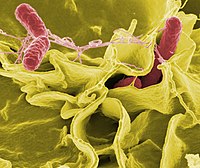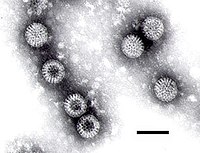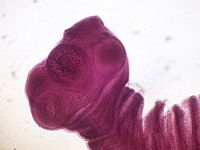Zatrucie pokarmowe
Zatrucie pokarmowe (łac. gastroenteritis acuta) – choroba wynikająca ze spożycia pokarmu lub przyjęcia płynów zawierających substancje szkodliwe, a w szczególności toksyny bakteryjne, drobnoustroje lub oba naraz i przebiegająca z objawami ostrego nieżytu żołądkowo-jelitowego. Według klasyfikacji WHO zatrucia pokarmowe obejmują również zakażenia pokarmowe.
Czynniki patogenne
Bakterie
Bakterie są najczęstszą przyczyną zatruć pokarmowych.
Najczęstszymi patogenami bakteryjnymi w zatruciach pokarmowych są:
- Campylobacter jejuni, który wtórnie może doprowadzić do zespołu Guillaina-Barrégo i zapaleń przyzębia[1]
- Salmonella spp. - zakażenie wywołane przez S. Typhimurium, które jest spowodowane spożyciem niedogotowanych jajek, a także inne patogeny[2][3][4]
- Escherichia coli O157:H7 (EHEC), które powodują zespół hemolityczno-mocznicowy
Inne częste patogeny bakteryjne:
- Bacillus cereus
- Escherichia coli - EIEC, EPEC, ETEC, EAEC, inaczej EAgEC
- Listeria monocytogenes
- Shigella spp.
- Staphylococcus aureus
- Streptococcus
- Vibrio cholerae, w tym O1 i nie-O1
- Vibrio parahaemolyticus
- Vibrio vulnificus
- Yersinia enterocolitica i Yersinia pseudotuberculosis.
Mniej powszechne czynniki bakteryjne:
- Brucella spp.
- Corynebacterium ulcerans
- Coxiella burnetii - gorączka Q
- Plesiomonas shigelloides.
Egzotoksyny
Niektóre zatrucia są wywoływane nie tylko bezpośrednio przez zakażenie bakteryjne, ale również egzotoksyny produkowane przez bakterie. Egzotoksyny produkują (przykłady):
- Clostridium botulinum
- Clostridium perfringens
- Staphylococcus aureus
- Bacillus cereus.
Mykotoksyny i zatrucia grzybami
Do mykotoksyn najczęściej wywołujących zatrucia pokarmowe należą:
- Aflatoksyny - wytwarzane przez Aspergillus parasiticus i Aspergillus flavus. Często występują w orzechach, orzeszkach ziemnych, kukurydzy, sorgo i innych nasionach oleistych. Do postaci aflatoksyn zalicza się: B1, B2, G1 i G2, wśród których aflatoksyna B1 działa głównie na wątrobę wywołując jej martwicę, marskość oraz raka wątrobowokomórkowego[5][6]
- Cytochalazyny
- Alkaloidy sporyszu - alkaloidy ergopeptynowe - ergotamina
- Inne
Wirusy
Zakażenia wirusowe stanowią prawdopodobnie jedną trzecią przyczyn zatruć pokarmowych w krajach rozwiniętych. Zakażenia wywołują wirusy:
- Enterowirusy
- Wirus zapalenia wątroby typu A, który szerzy się przez spożywanie pokarmów zanieczyszczonych fekaliami[7][8]
- Wirus zapalenia wątroby typu E
- Norowirusy
- Rotawirusy.
Pasożyty
Większość pokarmowych parazytoz to choroby odzwierzęce.
- Diphyllobothrium sp.
- Nanophyetus sp.
- Taenia saginata
- Taenia solium
- Fasciola hepatica
Zobacz też: tasiemce
- Anisakis sp.
- Ascaris lumbricoides
- Eustrongylides sp.
- Trichinella spiralis
- Trichuris trichiura.
- Acanthamoeba i inne wolno żyjące protozoa z supergrupy amoebozoa
- Cryptosporidium parvum
- Cyclospora cayetanensis
- Entamoeba histolytica
- Giardia lamblia
- Sarcocystis hominis
- Sarcocystis suihominis
- Toxoplasma gondii.
Toksyny występujące naturalnie w pokarmach
- alkaloidy (zawierają je np. szczwół plamisty i naparstnica)
- cykutoksyna w szaleju jadowitym
- toksyny grzybów wyższych
- tetrodotoksyna (ryby Takifugu)
- skombrotoksyna w rybach wywołująca scombrotoksizm
Przypisy
- ↑ Tom et al. Humphrey. Campylobacters as zoonotic pathogens: A food production perspective <internet>. „International Czasopismo of Food Microbiology”. 117 (3), 2007. DOI: 10.1016.
- ↑ Ingrid G. et al. Tribe: An outbreak of Salmonella Typhimurium phage type 135 infection linked to the consumption of raw shell eggs in an aged care facility <internet>. [dostęp 2007-08-12]. [zarchiwizowane z tego adresu (2008-06-18)].
- ↑ Centers for Disease Control and Prevention: Salmonella Infection (salmonellosis) and Animals <internet>. [dostęp 2007-08-12].Sprawdź autora:1.
- ↑ M. P. Doyle, M. C. Erickson: Reducing the carriage of foodborne pathogens in livestock and poultry <internet>. [dostęp 2007-08-12]. [zarchiwizowane z tego adresu (27 września 2007)].
- ↑ Center for Food Safety & Applied Nutrition: Aflatoxins <internet>. [dostęp 2007-08-12]. [zarchiwizowane z tego adresu (2007-12-17)].Sprawdź autora:1.
- ↑ Food and Agriculture Organization of the United Nations: GASGA Technical Leaflet - 3 Mycotoxins in Grain <internet>. [dostęp 2007-08-12]. [zarchiwizowane z tego adresu (12 stycznia 2017)].Sprawdź autora:1.
- ↑ Eric et al. Dubois: Intra-laboratory validation of a concentration method adapted for the enumeration of infectious F-specific RNA coliphage, enterovirus, and hepatitis A virus from inoculated leaves of salad vegetables <internet>. [dostęp 2007-08-11].
- ↑ Heather Martin Schmidt: Improving the microbilological quality and safety of fresh-cut tomatoes by low dose dlectron beam irradiation - Master thesis <internet>. [dostęp 2007-08-11]. [zarchiwizowane z tego adresu (27 September 2007)].
![]() Przeczytaj ostrzeżenie dotyczące informacji medycznych i pokrewnych zamieszczonych w Wikipedii.
Przeczytaj ostrzeżenie dotyczące informacji medycznych i pokrewnych zamieszczonych w Wikipedii.
Media użyte na tej stronie
The Star of Life, medical symbol used on some ambulances.
Star of Life was designed/created by a National Highway Traffic Safety Administration (US Gov) employee and is thus in the public domain.(c) Rjgalindo, CC-BY-SA-3.0
Сколекс свиного цепня (Оптический микроскоп 40×)
Color-enhanced scanning electron micrograph showing Salmonella Typhimurium (red) invading cultured human cells Credit: Rocky Mountain Laboratories, NIAID, NIH All the images, except specified ones from the World Health Organization (WHO), are in the public domain. For the public domain images, there is no copyright, no permission required, and no charge for their use.
Note the wheel-like appearance of some of the rotavirus particles. The observance of such particles gave the virus its name ('rota' being the Latin word meaning wheel). Bar = 100 nanometers.
Source: Cell culture.
Method: Negative-stain Transmission Electron Microscopy







